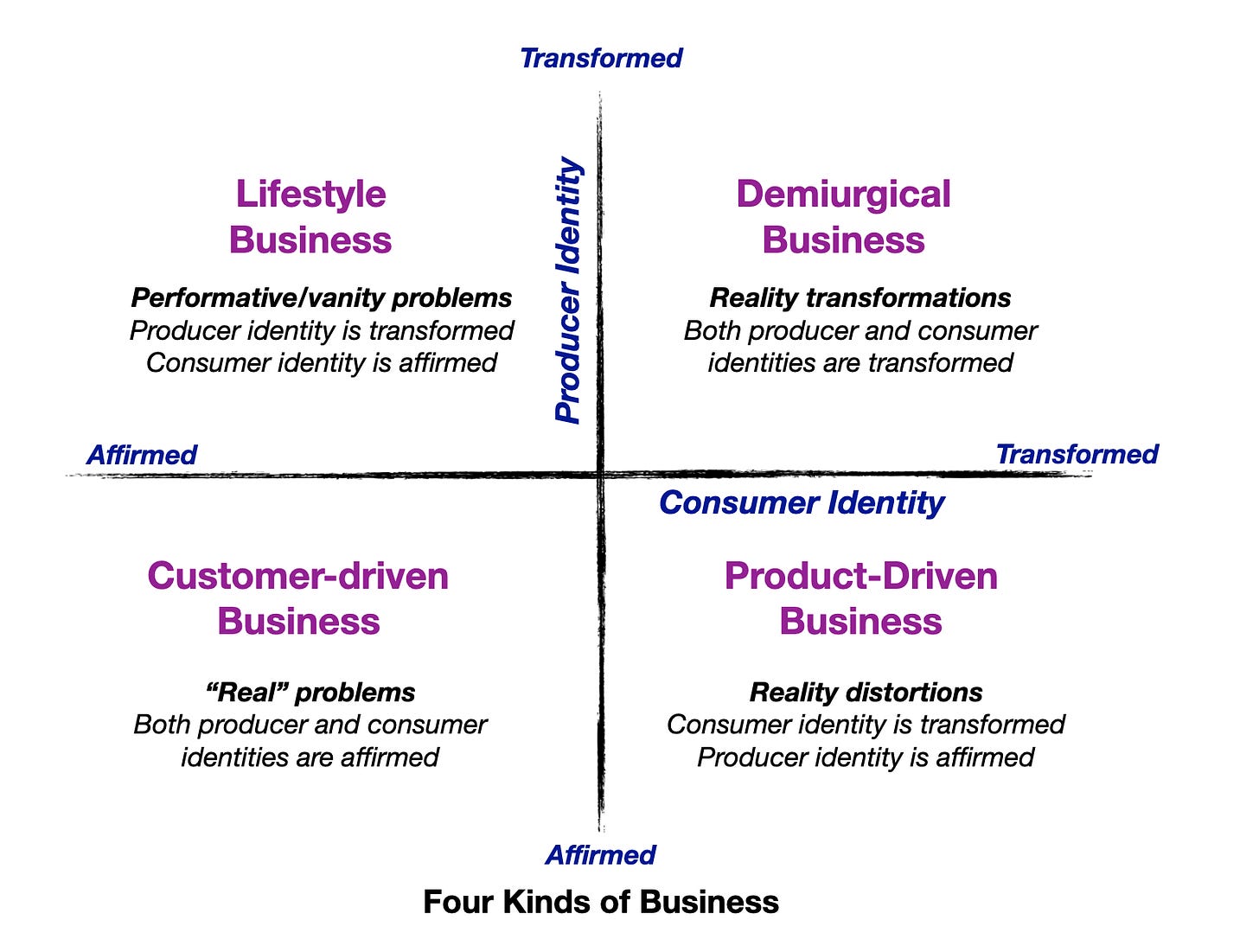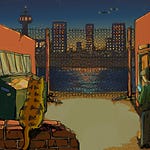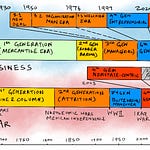In today’s episode of the Breaking Smart podcast, I want to discuss a concept I call demiurgical businesses that I think goes beyond the 3 kinds you may be familiar with: lifestyle, customer-driven, and product-driven.
1/ In the discourse around tech, both on the tech side and the techlash side, you’ll often hear the term “real problems” which should make you wonder what “unreal” problems are.
2/ When the term is used, it’s usually used by socially conscious people, whether builders or critics, who use “real problems” as the notional antithesis of whatever is behind what they see as bad, misplaced entrepreneurial priorities. Today it is NFTs, ten years ago it was apps.
3/ The term “real problem” is misleading because even though people who use the term will offer some cliched examples like climate tech or world hunger, the point of the term is to point at the thing being criticized, not the thing being aspired to.
4/ But if you take real and unreal seriously, you actually get an actually interesting train of thought. Usually, the thing being criticized is an example of a thing that doesn’t seem to solve any problem, whether real or made up.
5/ If you ask, “what problem does it solve?” about the thing being criticized, you’ll find that the people building it can’t even supply a bad, disingenuous, or morally indefensible answer.
6/ For example, if I answer the question, “what real problem does space exploration solve?” with “it helps discover better cancer drugs through zero-gravity biochemistry experiments,” you know that’s bullshit. It is obviously a rationalization. It’s both a bad answer and a disingenuous one. If you claim it is a real answer, you’re either stupid or lying. I discussed the real answer for that a couple of weeks ago.
7/ For a morally indefensible example, let’s say I build luxury yachts with built-in torture chambers. The answer to “what real problem does it solve” would be, “the problem dictators have of partying and torturing their enemies at the same time.” Now that’s a bad and morally indefensible answer, but it is actually a real answer that points to a real problem that a real person has, just not a very pleasant kind of person. I’d want such a yacht if I was an evil dictator.
8/ If you think about it, there is no such thing as an unreal problem. If it can be posed as a problem at all, it’s real. You just may not share the motives or values of the person who wants to solve it.
9/ Or to put it more simply, the idea of a “real problem” is actually an expression of identity. Evangelizing “real problems” is a way to do identity politics by indirect means. The problem you choose reveals who you are, what values you prioritize, and what identity you’re attached to.
10/ An easy way to see this is to notice that “real problems” are actually a generalization of “customer-driven.” A real problem points to a real person who already has that problem — namely a customer. Whether it is hungry children or evil dictators.
11/ It might be quite abstract — for example, the “customer” for climate tech is people who believe in climate change and also believe it’s good to ensure the survival of as many humans and animals as possible, and will vote for politicians who will make policies in favor of that. But it’s still a direct equation between being customer-driven and focusing on “real problems.”
12/ I’ll even go further and say that all identities are in fact customer identities. So identity politics is actually customer politics. The only reason to have a stable identity is if you want to acquire something through it, whether it is through participation in family, community, the market, or politics. So things like race and ideology are customer identities just like preferring vanilla over chocolate ice cream is a customer identity. You buy things through those identities, even if it isn’t with money.
13/ If you’re familiar with the idea from Peter Drucker that the purpose of a business is to create a customer, this equivalence between “real problems” and pre-existing identities should be a red-flag for you. It means you’re talking about a world where innovation gets reduced to exceptional customer service through incremental improvements.
14/ So let’s ask again, what is the actual logical opposite of a “real problem?” We’ve already seen that “unreal problem” goes nowhere, and that “real” is just indirectly about affirming an identity, possibly while criticizing other identities.
15/ Here is my proposal: the opposite of a “solution to a real problem” — real to anybody, whether you think they are good or evil — is a “reality transformer.” Instead of solving a problem within reality as currently defined, in relation to a particular identity-based point of view, you make something that creates a new reality, forcing people to create new identities in relation to it.
16/ Twitter is my favorite example of a reality transformation business, or what I call a demiurgical business. Nobody asked for it, and even 14 years later it is unclear what problem it solves, and for whom. It was built because it was possible to build, and it ended up transforming reality for everybody. Now people have “real problems” within the expanded Twitter reality, such as being able to edit tweets.
17/ I used to think of this point of view as simply being “product-driven” instead of “customer driven” — see the potential within a new technological capability and work to realize it in a way that creates a new kind of customer, ie. catalyzes new identities in the market. I wrote a popular article about this in 2014, called Product-Driven vs. Customer-Driven, but that article now feels incomplete to me.
18/ The thing is, though product-driven businesses are in general more powerful than customer-driven things, most product-driven businesses are also often degenerate customer-driven things in disguise, where the customer is the entrepreneur. So you could call it entrepreneur-driven.
19/ An entrepreneur-driven business solves the problem of affirming the hardened, often narcissistic identity of the entrepreneur as the only real customer. They may want to put a dent in the universe, but typically they don’t want to put even a scratch on themselves. They want to transform without being transformed. Everything else is a side-effect.
20/ The side-effect is usually what we call product-driven: it creates a customer rather than serving an existing market. But the most important customer, the entrepreneur, remains unchanged.
21/ In my experience, I’d say about 90% of entrepreneurs are customer-driven. They build boring businesses that solve an existing problem for an existing customer, and make themselves and some others rich. About 9% are entrepreneur-driven: they work to validate the identity of the entrepreneur, and might distort reality for everybody else except the entrepreneur, via a reality-distortion product. That leaves the last 1%.
22/ This last 1% is what I think of as the truly powerful things. They transform reality for everybody, including for the person making it, forcing everybody to forge new identities. They transcend the product-driven vs. customer-driven dichotomy. Twitter is an example of this kind of business. It may have under-performed as a business compared to entrepreneur-driven businesses like Apple, Amazon, and Facebook, but it transformed reality more powerfully.
23/ It feels wrong to call the creators of such products mere entrepreneurs, since they are typically not about merely building a successful business or even validating their own identity. They act in the role of what the Greeks and gnostics called a demiurge. Not quite a god, and not quite human. Agents of transformation who are themselves part of the transformation process and subject to it.
24/ Demiurgical businesses tend to be far more powerful than either customer-driven or product-driven businesses, even when they make less money. The limiting factor for customer driven businesses is existing identities in the market that can be served. The limiting factor for product-driven businesses is the existing identity of the entrepreneur that must be affirmed. But a demiurgical business essentially has no limits besides the laws of nature.
25/ Demiurgical businesses often convey the impression of having escaped the control of their creators. I once described Twitter as occupying a business space that is too big to nail, a play on “too big to fail.” Just too large for any one business to fully occupy, and beyond the ability of any human CEO to govern. It’s not that the founders of Twitter were significantly less capable than those of Amazon, Apple, Facebook, or Google. It is that Twitter opened up a transformed reality that was too big to nail.
26/ In my experience, it’s definitely not the case that people who build demiurgical businesses are somehow more evolved or enlightened than regular entrepreneurs. Often, they are just as narcissistic and driven to validate their own fixed identity as product or customer-driven entrepreneurs. What happens is something like a natural accident. They stumble on an idea that is too powerful to be limited by their own identity. They have no choice in the matter. The thing they unleash transforms them, whether they want be transformed or not.
27/ You can reduce this whole idea to a 2x2: if the producer, or entrepreneur changes but the consumer doesn’t, you essentially have a lifestyle business. If neither changes, you have a commodity customer-driven business. If the consumer is transformed, but the producer is not, you have a product-driven business. If both are transformed, you have a demiurgical business.
28/ Personally, I like demiurgical businesses the most. They have the most powerful effects on our world, and are the only kind of business that can break humanity out of seemingly hopeless equilibriums, where everybody has locked-in identities, and is fixated on “real problems” instead of “transforming reality.”
29/ In fact, flipping things around, the things usually called “real problems” are in fact the most “unreal” of all. The fact that they exist as persistent, named conditions that seem to defy solution, and demand really virtuous behavior of humans suggests that there is a misframing going on somewhere. A problem that requires humans to be saints to drive solutions is not a problem. It is virtue blindness.
30/ Real problems are problems that real humans, not saintly ones, can solve. If existence is threatened by a huge problem that require us all to transform into saints to solve, then the problem is actually unreal since it involves imaginary, fictional human beings. The actual response to such problems is to transform reality in unpredictable ways through demiurgical businesses. That’s what can get the situations unstuck. Maybe in the transformed reality, the problem is actually possible for real humans to solve.












Demiurgical Businesses